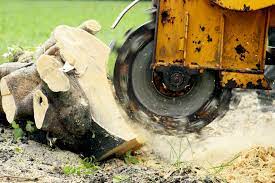Stump grinding is an essential process in landscaping and forestry management. It involves the removal of tree stumps, which can be unsightly, obstructive, and even hazardous. Understanding the science behind stump grinding can shed light on why it’s necessary and how it’s accomplished.
The Anatomy of a Stump
Before delving into the process of stump grinding, it’s essential to understand the anatomy of a tree stump. When a tree is cut down, the remaining stump consists of several layers. At the center lies the heartwood, which is the older, non-living part of the tree. Surrounding the heartwood is the sapwood, which is responsible for transporting water and nutrients throughout the tree. Finally, there’s the bark, which acts as a protective layer for the tree.
The Need for Stump Removal
While leaving tree stumps in place might seem harmless, they can pose several problems. Firstly, they can be a tripping hazard, especially when they’re concealed by grass or other vegetation. Additionally, tree stumps can attract pests like termites, which may eventually spread to nearby structures. Moreover, they can hinder landscaping efforts, making it difficult to mow the lawn or plant new vegetation. Thus, removing tree stumps becomes necessary for safety, aesthetics, and environmental reasons.
Understanding Stump Grinding
Unlike traditional stump removal techniques like digging or burning, stump grinding involves using specialized equipment to grind the stump into small wood chips. This process is not only faster but also less invasive, preserving the surrounding landscape.
The Equipment Involved
Stump grinding machines come in various sizes, from small handheld grinders to large industrial-grade equipment. These machines feature a rotating cutting wheel with sharp teeth that effectively grind away the stump. The depth to which the stump is ground depends on the size of the grinder and the specific requirements of the job.
The Process
The process of stump grinding typically begins with assessing the stump’s size, location, and surrounding terrain. This evaluation helps determine the appropriate grinder size and approach. Once the equipment is set up, the operator systematically grinds away the stump, starting from the perimeter and working towards the center. The grinding continues until the stump is reduced to wood chips and mulch, which can be used as organic matter in landscaping.
Benefits of Stump Grinding
Firstly, it’s cost-effective, as it eliminates the need for extensive manual labor or heavy machinery. Moreover, it’s environmentally friendly since it doesn’t involve chemicals or burning, which can release harmful emissions. Additionally, stump grinding preserves the integrity of the surrounding landscape, minimizing disruption to grass, plants, and soil.
Tree Removal and Stump Grinding Adelaide: A Case Study
In Adelaide, like in many urban and suburban areas, tree removal and stump grinding are common practices. Adelaide’s diverse urban landscape includes a mix of native and exotic tree species, making stump removal essential for maintaining a safe and aesthetically pleasing environment. Professional Tree Removal And Stump Grinding Services In Adelaide adhere to industry standards and regulations to ensure safe and efficient operations.
Conclusion:
Stump grinding is a scientifically proven method for effectively removing tree stumps. By understanding the anatomy of a stump and the process of stump grinding, it becomes evident why this method is preferred for stump removal. With the right equipment and expertise, tree removal and stump grinding Adelaide services contribute to maintaining the beauty, safety, and functionality of urban and suburban landscapes. Whether it’s for residential, commercial, or municipal properties, investing in stump grinding ensures a cleaner, safer, and more attractive outdoor environment.










